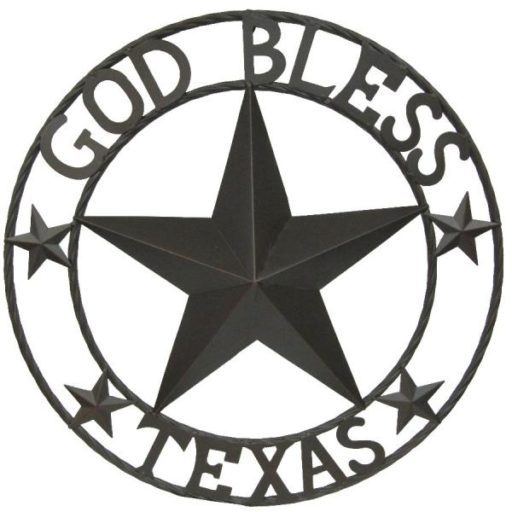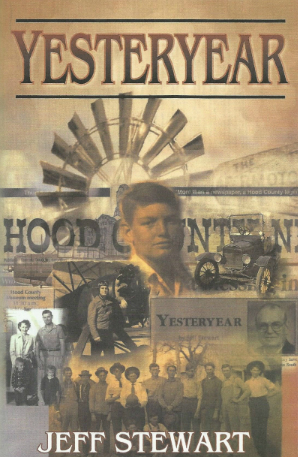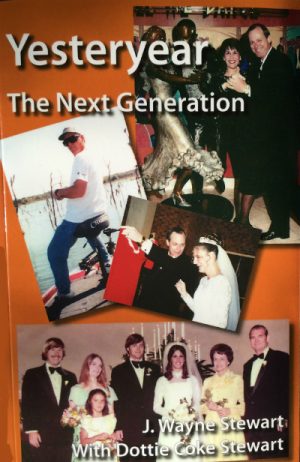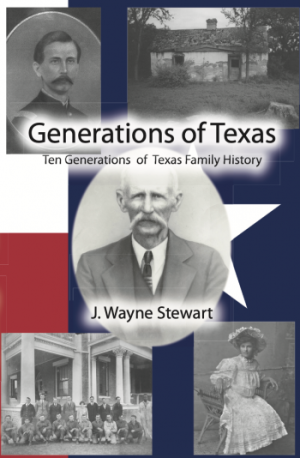Description
Yesteryear is Jeff Stewart’s book on his generation, a compilation of his newspaper columns describing farming in Depression-era West Texas, fighting in World War II, and making the transition from farmer to insurance executive. He documents the first 6 of the family’s 10 Generations of Texans, from the early-1800s through the twentieth century. Yesteryear is filled with wit and folksy humor, remembrances of a way of life that is no more, and a window into the struggles and successes of a “salt of the earth” bedrock family.
An excerpt from Yesteryear.
MAKING SPENDING MONEY
“When I was young, it wasn’t always easy to make spending money. Kids did not get paid for working on the farm, for that was the whole family’s responsibility.
“When the family went to town on Saturday afternoon, we younger children were usually given a dime each to buy “treats” – a triple-decker ice cream cone, a big size bottle of cola or fruit drink, or an extra-large snowcone cost a nickel each – but a weekly spending allowance for farm kids was not the usual practice. In addition to our eats and drinks, we youngsters had to go to the flickering, eight-millimeter “picture show” to see a good “western.” These tickets were ten cents each, meaning we usually had to spend some of our own money; so farm kids were always looking for ways to make some additional spending money.
“The money making activities for farm kids varied greatly. Some kids had their own little flock of chickens and sold eggs. Others were allowed to own one or two cows or sows, and sold the calves or pigs. Some went the farming route by being allowed to have a small patch of cotton, corn, wheat, oats, or some produce or “truck farming” crops such as watermelons or cantaloupes.
“My approach to this rather important matter was two-fold. When not working at home, I did some work for other people, particularly a neighbor on his Fort Belknap area fruit farm. Most of this money, however, was needed to buy clothes or other necessities; so I used my favorite hobby, hunting, to bring in some extra spending money.
“There was always a market in the wintertime for animal pelts, when the skins were “prime” (thick and heavy to withstand the winter weather). I usually skinned and stretched some opossum hides, with occasional raccoon or bobcat skins being added to my inventory. Even in those days, an exceptional ‘possum skin brought fifty cents with the average ones more in the quarter range. The coon and bobcat pelts sold for a little more, but coyote and rabbit skins were considered worthless, quite different from today. Skunk pelts brought the best prices of all, but I absolutely refused to have anything to do with these smelly creatures.
“At times I did some trapping with steel traps, but since they were more effective for skunks than ‘possums, my skins were usually obtained by hunting. Pulling or “twisting” ‘possums from their dens in hollow trees was, by far, the most effective method of obtaining skins. Twisting out an animal was a simple matter. After finding ‘possum hairs around the opening into a hollow tree or limb, a forked stick was pushed down firmly on the animal and twisted into its loose skin. The snarling and scratching animal could then be pulled from its den.
“The fresh skins were removed in a way that left the pelts intact except for openings at the back end. They were stretched over boards to dry, so they could be preserved for the market (nowadays the fresh skins are put in plastic bags and stored in the freezer). I didn’t make much money from the fur market, but it was a fun thing to do. (I understand some rural youngsters still engage in trapping activities, but their approach probably is much more sophisticated now than back then.)
“My most enjoyable way to make spending money, however, was to take advantage of the bounty laws that were in effect in most counties. Coyotes usually brought a bounty, but they were caught, primarily, by government hunters using traps. However, the jackrabbit bounty was a different matter. There’s where my hunting ability with my 22 rifle meant something. The bounty for a pair of jackrabbit ears was five cents. The ears were used as evidence of the kill, since they could be cut off intact just at the top of the head. The ears are composed of only cartilage and furry skin; so there was no decaying smell to worry about. My collection of jackrabbit ears was taken to the county courthouse to collect the bounty. A box of fifty cartridges cost fifteen to twenty cents, so besides the fun of hunting the long-eared rabbits, there was a good profit involved.
“I was always on the lookout for jackrabbits, but during the spring growing season hunting them was a cinch. They loved to eat young cotton plants, as evidenced by skips in some rows of cotton thirty or forty feet in length, where some big rabbits had eaten every plant in the row. Many late afternoon spring days found me hunting in and around cotton fields collecting rabbit ears. My hunting style was unique. It consisted of crawling across the rows of cotton and looking both ways for jackrabbits. When one of the big fellows was seen eating away within a hundred yards of me, the 22 long rifle hollow-point cartridge usually meant another nickel.
“My trusty 22 rifle occasionally allowed me to engage in barter activities also, which tended to conserve my spending money. Two or three times each year small carnivals visited the town of Newcastle, close to where we lived. In addition to the usual carnival sideshow activities and the boxing and wrestling matches, they normally had a small zoo containing a few carnivorous animals such as lions, tigers, bears, cougars, and wolves. To reduce their rather substantial feeding costs, the carnival companies generally exchanged free passes for fresh meat, usually rabbits, to feed the animals. Needless to say, it was seldom necessary for me to use my own money to attend any of the showtime activities.
“Modern kids probably have an easier time making spending money than kids did sixty years ago. I doubt, however, that many of them have any more fun doing so than I did as a youngster on the farm.”





Reviews
There are no reviews yet.